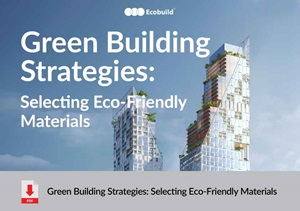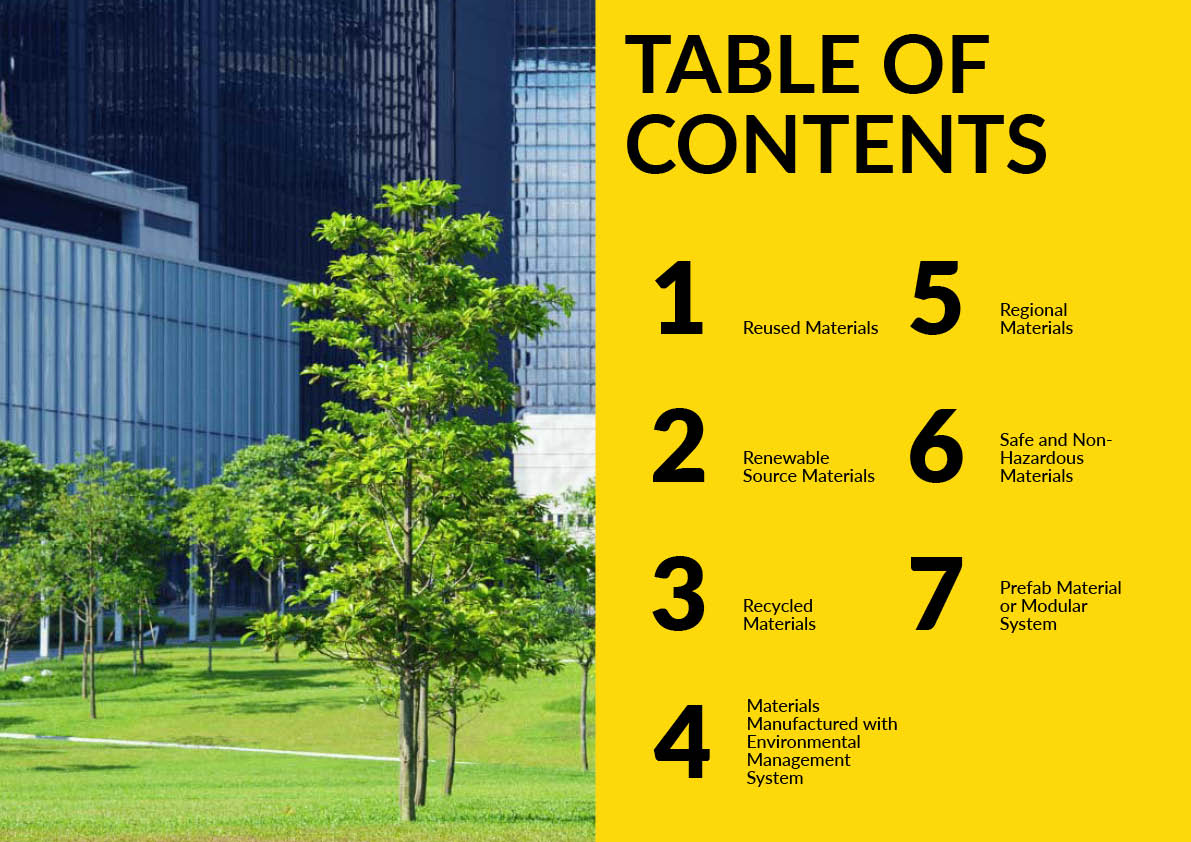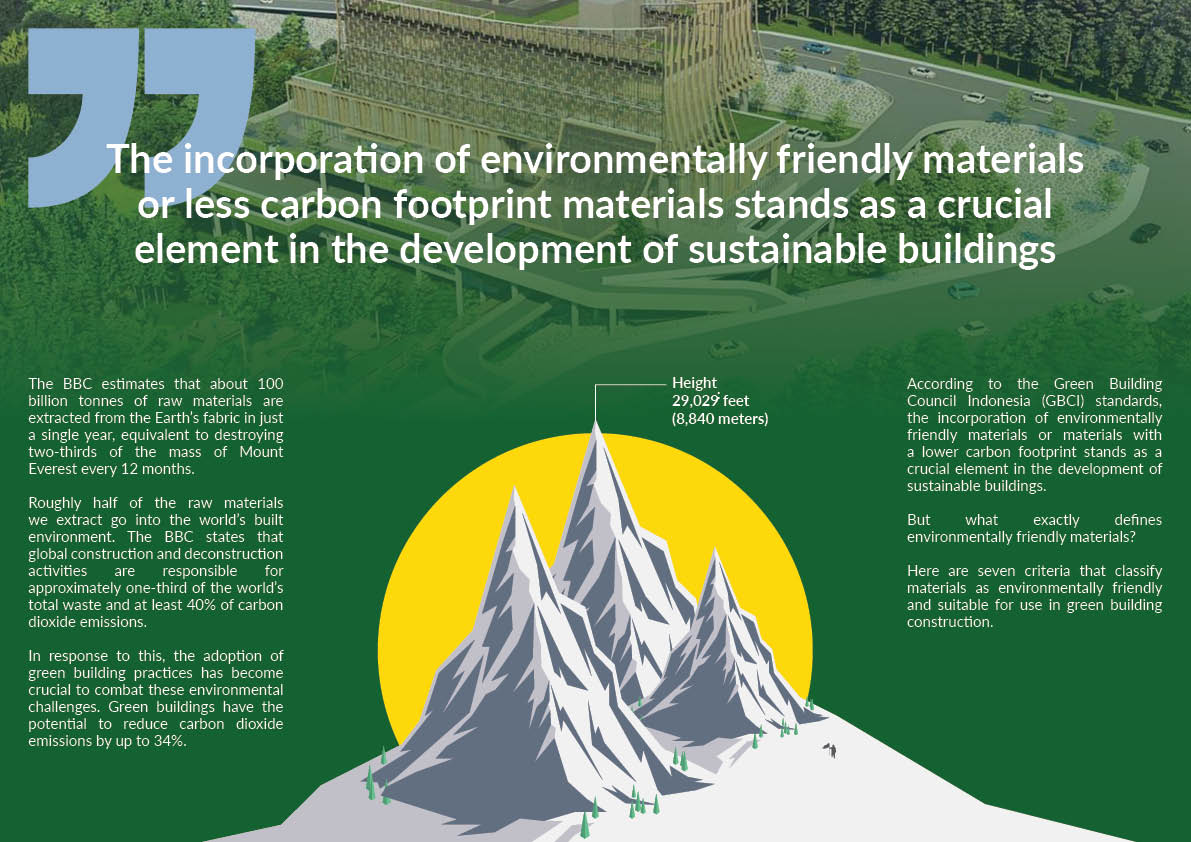The incorporation of environmentally friendly materials or less carbon footprint materials stands as a crucial element in the development of sustainable buildings
The BBC estimates that about 100 billion tonnes of raw materials are extracted from the Earth’s fabric in just a single year, equivalent to destroying two-thirds of the mass of Mount Everest every 12 months.
Roughly half of the raw materials we extract go into the world’s built environment. The BBC states that global construction and deconstruction activities are responsible for approximately one-third of the world’s total waste and at least 40% of carbon dioxide emissions.
In response to this, the adoption of green building practices has become crucial to combat these environmental challenges. Green buildings have the potential to reduce carbon dioxide emissions by up to 34%.
According to the Green Building Council Indonesia (GBCI) standards, the incorporation of environmentally friendly materials or materials with a lower carbon footprint stands as a crucial element in the development of sustainable buildings.
But what exactly defines environmentally friendly materials?
Here are seven criteria that classify materials as environmentally friendly and suitable for use in green building construction.
- Reused Materials
The rapid expansion of the economy, continuous population growth, and increased demand for products and services have resulted in the depletion of Earth’s resources.
In response to this urgent matter, the European Commission Waste Framework Directive 2008/98/EC (EU, 2008) and the Demolition Protocol (ICE, 2008) have introduced waste hierarchies which state that the second-best solution after waste prevention is reuse.
Despite the preference for reuse over recycling according to waste hierarchies, most construction and demolition wastes (CDW) are recycled rather than reused. In the UK, for example, nearly 91% of non-hazardous CDW is recycled (Defra, 2019).
However, recycling processes are energy and resource-intensive, and they impose significant environmental pressure in terms of greenhouse gas (GHG) emissions and other pollutants (Addis, 2006; WRAP, 2008).
In contrast, reusing building components such as bricks, beams, columns, and trusses has much lower environmental impacts compared to recycling (Geyer et al., 2002). For instance, reusing reclaimed structural steel or timber sections can reduce environmental impacts by 96% and 83%, respectively, as reported by Lazarus (2003).
This is primarily due to the significantly lower treatment and reprocessing required for building component reuse (BCR) compared to recycling (Gorgolewski et al., 2008).
Despite the environmental benefits, this strategy is not yet widely implemented in the building industry. New design methods such as design for deconstruction (DfD) (Akidane et al., 2017; Tingey and Davison, 2011) and design for manufacture and assembly (DfMA) (Kalyun and Wodajo, 2012) need to be introduced to mitigate the vast amount of waste generation during refurbishment or demolition.
- Renewable Source Materials
The industrialization of the construction industry brought financially efficient technologies such as mass-produced bricks, concrete, and steel. These materials are cost-effective and require low skill levels for conversion into buildings.
However, they all share a common drawback of high energy costs during extraction, processing, and transportation. Additionally, these materials are derived from finite (albeit abundant) resources.
Once extracted and utilized, the raw materials are permanently depleted, and with historically low levels of recycling, a significant amount of these materials is lost to future generations who will face increasing scarcity of resources (Lawrence, 2015).
To address this, the use of materials derived from renewable sources is recommended.
Renewable materials suitable for construction are essentially those that can be sustainably replenished within relatively short timeframes. The Green Building Council Indonesia (GBCI) criteria for renewable materials require a maximum harvest period of 10 years.
These primarily include bio-based materials derived from plants and animals, which can be harvested and regenerated within years or decades, as opposed to centuries or longer durations.
The energy involved in the formation of these raw construction materials, such as timber, is largely derived from solar energy through photosynthesis.
These unprocessed materials result in significantly less pollution as they retain their natural biodegradability.
- Recycled Materials
Green Building Council Indonesia (GBCI) defines recycling as a process that involves utilizing the same materials and leveraging energy or other resources to create new products with the aim of transforming a part of the old material into something fresh and innovative.
Recycled materials can be considered to have lower embodied energy because the initial energy consumed during their manufacturing has already been accounted for in their previous use (Lawrence, 2015).
Only the additional energy required for their collection, recycling, and transformation into new products contributes to the embodied energy of the final product.
Through recycling, these materials are “renewed” to some extent, extending their lifespan.
However, it is important to note that many recycled materials originate from finite, non-renewable resources, such as steel, derived from raw materials that are difficult to recover and require energy-intensive extraction processes.
By recycling used materials, the need for extracting new resources can be reduced.
Rebricks is one example of construction material made from recycled plastic waste. Rebricks are processed with a more sustainable method that does not incorporate plastic burning. It aims for economic circularity with a possible lifetime of 20+ years. Additionally, it is also reusable, recyclable, and remanufactured.
- Materials Manufactured with Environmental Management System
Industrial processes involved in manufacturing materials can have adverse effects on the environment, resulting in pollution and potential risks to human health.
Implementing an Environmental Management System helps minimize these negative impacts, optimizing industrial operations while maintaining environmental balance.
ISO 14001:2015 is an internationally agreed standard that outlines the criteria for implementing an environmental management system to encourage better environmental performance of suppliers.
This environmental management system helps organizations identify, manage, monitor, and control their environmental issues in a holistic manner.
This standard assists organizations in enhancing their environmental performance by promoting efficient resource utilization and waste reduction.
By adhering to ISO 14001:2015, organizations can gain a competitive edge and build trust among stakeholders by demonstrating their commitment to sustainable practices.
- Regional Materials
The transportation of materials from production sites to construction sites is a crucial aspect of the construction industry. However, this process often relies heavily on oil-fueled transportation, which leads to adverse environmental impacts such as air pollution and carbon emissions.
To mitigate these issues, a sustainable approach involves the utilization of regional materials sourced within a 1,000 km radius from the construction site. This practice aims to minimize the need for long-distance transportation, thereby reducing fuel consumption and the associated pollution.
Numerous studies have highlighted the environmental benefits of utilizing regional materials in construction. A study conducted by Guinée et al. (2002) examined the life cycle environmental impacts of building materials. The research concluded that using materials sourced locally resulted in reduced transportation-related impacts, including energy consumption and emissions.
Furthermore, the U.S. Green Building Council’s Leadership in Energy and Environmental Design (LEED) certification program recognizes the importance of regional materials in sustainable construction practices. The LEED Materials and Resources credit category includes credits for the use of regional materials, encouraging construction projects to source materials from nearby locations.
In a report by the World Green Building Council (2013), it was emphasized that incorporating regional materials reduces the carbon footprint of construction projects. The report also highlighted that sourcing materials locally supports regional economies and reduces reliance on long-distance transportation networks.
The reduction in long-distance transportation not only decreases fuel consumption and associated carbon emissions but also supports local economies and enhances the overall sustainability of the construction industry.
- Safe and Non-Hazardous Materials
The Green Building Council Indonesia (GBCI) encourages the assessment of the potential hazards and risks associated with various building materials.
This assessment involves considering the materials’ chemical composition, toxicity, and potential for release of harmful substances during production, use, and disposal phases.
ISO 14001:2015 also encourages organizations to prioritize the use of environmentally friendly materials, such as those with low volatile organic compound (VOC) emissions, reduced energy requirements for production, and recyclability or biodegradability at the end of their life.
Some common hazardous materials found in buildings, as mentioned by the US Green Building Council and Green Globes, include:
- Polyvinyl Chloride (PVC): This plastic releases hazardous chemicals throughout its lifecycle and can be present in various products like pipes, insulation, flooring, fabrics, and ceilings.
- Halogenated Flame Retardants (HFRs): These chemicals, used to enhance heat and flame resistance, include hazardous variants. HFRs can be found in heating, ventilation, and cooling systems, furniture, and electronics.
- Respirable Silica: This respiratory irritant can cause pulmonary disease and is found in cementitious and earthen building materials.
- Radioactive Isotopes: Isotopes used in ionization-type smoke detectors and compact fluorescent lamps can emit radioactive particles, leading to radiation poisoning and other health issues.
- Asphalt: Often used in adhesives and roofing materials, asphalt fumes are irritating, and prolonged exposure can be hazardous.
- Cadmium: Used as a rust inhibitor, cadmium fumes generated during heating processes can be hazardous.
- Glass Fiber: Found in insulation and plastic reinforcement, glass fiber is an irritant to the eyes, skin, and respiratory system.
- Mineral Wool: Used in insulation and building products, mineral wool is an irritant to the eyes, skin, and respiratory system and may contain hazardous materials like silica and asbestos.
- Other Materials: Like lead, mercury, asbestos, and polychlorinated biphenyls (PCBs), although not used in new materials or devices, are recognized as hazardous and may still be encountered.
- Prefab Material or Modular System
Prefabricated materials or modular systems are constructed in factories with detailed designs tailored to specific construction sites.
This approach minimizes waste during the construction process and enables faster installation.
Findings based on a life cycle assessment comparing two construction systems (prefabrication and conventional) and different structural systems for single-family houses indicated that wooden frame had the lowest environmental impacts, followed by lightweight steel frame.
It was observed that embodied impacts, which encompass the environmental effects associated with the construction materials and processes, could account for over half of the total impacts.
Prefabricated houses demonstrated a remarkable reduction of up to 65% in embodied impacts compared to traditional construction methods.
Additionally, prefabricated LSF (Light Steel Frame) construction exhibited lower end-of-life impacts due to recycling practices, underscoring the significance of both the embodied and end-of-life phases in sustainability assessments.
The adoption of prefabrication techniques has the potential to minimize impacts, reduce materials consumption, and limit waste generation, thereby promoting circularity and sustainability within the construction industry.
Closing statement:
By adhering to these criteria when selecting materials for building construction, carbon emissions can be reduced, and a balanced environment can be maintained.
Furthermore, the use of environmentally friendly materials promotes the development of cost-effective and energy-efficient green buildings.
You can read the full article about Green Building Strategies: Selecting Eco-Friendly Materials below.





